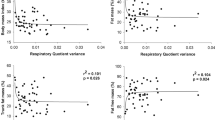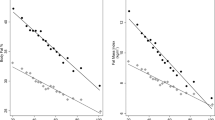Abstract
Objective:
To identify the characteristics of physical activity that are the most correlated to total and truncal fatness and to physiological parameters involved in fat oxidation in elderly men.
Design:
Cross-sectional study.
Subjects:
A total of 25 healthy elderly men selected with a wide range of physical activity behavior (65.9±3.4 years).
Measurements:
Total and truncal fat masses (by dual-energy X-ray absorptiometry), time spent and energy expended (EEday) at specific activity intensities (<40, 40–60, >60% VO2max) during 1 week in free living conditions (using heart rate recording and individual calibrated equations), sport-exercising volume (Vsport, using Baecke questionnaire), maximal oxygen uptake (VO2max), muscle fat oxidative capacity (OXFA, using muscle biopsy), lipid oxidation and respiratory exchange ratio during exercise at 50% VO2max (using indirect calorimetry).
Results:
Vsport was the main determinant of total and truncal fatness, VO2max and OXFA (r=−0.69, P<0.0001; r=−0.80, P<0.0001; r=0.70, P<0.0001; r=0.66, P<0.001, respectively). Among physical activity parameters measured over a week, total EEday was the main determinant of total fat mass. Furthermore, EEday at % VO2max>60 was closely correlated to truncal fat mass, VO2max and OXFA (r=−0.58, P>0.01; r=0.55, P<0.01; r=0.49, P<0.05, respectively). Finally, VO2max and OXFA were positively correlated to absolute fat oxidation and to the contribution of fat to energy production during moderate exercise.
Conclusion:
Sport-exercising volume is the main factor regulating total and truncal fat masses and physiological parameters involved in fat oxidation. With regard to the characteristics of physical activity, overall energy expended during the alert period plays a major role in the regulation of total body fatness. In addition, vigorous exercises may be beneficial for the regulation of abdominal fat depot partly through the stimulation of muscle fat oxidation during the effort.
This is a preview of subscription content, access via your institution
Access options
Subscribe to this journal
Receive 12 print issues and online access
$259.00 per year
only $21.58 per issue
Buy this article
- Purchase on Springer Link
- Instant access to full article PDF
Prices may be subject to local taxes which are calculated during checkout


Similar content being viewed by others
References
Brooks GA, Mercier J . Balance of carbohydrate and lipid utilization during exercise: the "crossover" concept. J Appl Physiol 1994; 76: 2253–2261.
Achten J, Jeukendrup AE . Optimizing fat oxidation through exercise and diet. Nutrition 2004; 20: 716–727.
Friedlander AL, Casazza GA, Horning MA, Usaj A, Brooks GA . Endurance training increases fatty acid turnover, but not fat oxidation, in young men. J Appl Physiol 1999; 86: 2097–2105.
Morio B, Hocquette JF, Montaurier C, Boirie Y, Bouteloup-Demange C, McCormack C et al. Muscle fatty acid oxidative capacity is a determinant of whole body fat oxidation in elderly people. Am J Physiol Endocrinol Metab 2001; 280: E143–E149.
Zurlo F, Nemeth PM, Choksi RM, Sesodia S, Ravussin E . Whole-body energy metabolism and skeletal muscle biochemical characteristics. Metabolism 1994; 43: 481–486.
Pate RR, Pratt M, Blair SN, Haskell WL, Macera CA, Bouchard C et al. Physical activity and public health. A recommendation from the Centers for Disease Control and Prevention and the American College of Sports Medicine. JAMA 1995; 273: 402–407.
NIH Consensus Development Panel on Physical Activity and Cardiovascular Health. Physical activity and cardiovascular health. JAMA 1996; 276: 241–246.
Centers for Disease Control and Prevention. Surgeon General's report on physical activity and health. JAMA 1996; 276: 522.
Erlichman J, Kerbey AL, James WP . Physical activity and its impact on health outcomes. Paper 2: Prevention of unhealthy weight gain and obesity by physical activity: an analysis of the evidence. Obes Rev 2002; 3: 273–287.
Saris WH, Blair SN, van Baak MA, Eaton SB, Davies PS, Di Pietro L et al. How much physical activity is enough to prevent unhealthy weight gain? Outcome of the IASO 1st Stock Conference and consensus statement. Obes Rev 2003; 4: 101–114.
Blair SN, LaMonte MJ, Nichaman MZ . The evolution of physical activity recommendations: how much is enough? Am J Clin Nutr 2004; 79: 913S–920S.
Conn VS, Minor MA, Burks KJ, Rantz MJ, Pomeroy SH . Integrative review of physical activity intervention research with aging adults. J Am Geriatr Soc 2003; 51: 1159–1168.
Starling RD . Energy expenditure and aging: effects of physical activity. Int J Sport Nutr Exerc Metab 2001; 11 (Suppl): S208–S217.
Baecke JA, Burema J, Frijters JE . A short questionnaire for the measurement of habitual physical activity in epidemiological studies. Am J Clin Nutr 1982; 36: 936–942.
Morio B, Montaurier C, Ritz P, Fellmann N, Coudert J, Beaufrere B et al. Time-course effects of endurance training on fat oxidation in sedentary elderly people. Int J Obes Relat Metab Disord 1999; 23: 706–714.
Lazzer S, Boirie Y, Bitar A, Montaurier C, Vernet J, Meyer M et al. Assessment of energy expenditure associated with physical activities in free-living obese and nonobese adolescents. Am J Clin Nutr 2003; 78: 471–479.
Black AE, Coward WA, Cole TJ, Prentice AM . Human energy expenditure in affluent societies: an analysis of 574 doubly-labelled water measurements. Eur J Clin Nutr 1996; 50: 72–92.
Weir JB . New methods for calculating metabolic rate with special reference to protein metabolism. 1949. Nutrition 1990; 6: 213–221.
Guillet C, Prod'homme M, Balage M, Gachon P, Giraudet C, Morin L et al. Impaired anabolic response of muscle protein synthesis is associated with S6K1 dysregulation in elderly humans. FASEB J 2004; 18: 1586–1587.
Levine JA, Eberhardt NL, Jensen MD . Role of nonexercise activity thermogenesis in resistance to fat gain in humans. Science 1999; 283: 212–214.
Bergman BC, Butterfield GE, Wolfel EE, Casazza GA, Lopaschuk GD, Brooks GA . Evaluation of exercise and training on muscle lipid metabolism. Am J Physiol 1999; 276: E106–E117.
Carter SL, Rennie C, Tarnopolsky MA . Substrate utilization during endurance exercise in men and women after endurance training. Am J Physiol Endocrinol Metab 2001; 280: E898–E907.
Bergman BC, Brooks GA . Respiratory gas-exchange ratios during graded exercise in fed and fasted trained and untrained men. J Appl Physiol 1999; 86: 479–487.
Coggan AR, Raguso CA, Gastaldelli A, Sidossis LS, Yeckel CW . Fat metabolism during high-intensity exercise in endurance-trained and untrained men. Metabolism 2000; 49: 122–128.
Nemet D, Connolly PH, Pontello-Pescatello AM, Rose-Gottron C, Larson JK, Galassetti P et al. Negative energy balance plays a major role in the IGF-I response to exercise training. J Appl Physiol 2004; 96: 276–282 (Epub 2003 August 29).
Loucks AB . Energy balance and body composition in sports and exercise. J Sports Sci 2004; 22: 1–14.
Tremblay A, Despres JP, Leblanc C, Craig CL, Ferris B, Stephens T et al. Effect of intensity of physical activity on body fatness and fat distribution. Am J Clin Nutr 1990; 51: 153–157.
Visser M, Launer LJ, Deurenberg P, Deeg DJ . Total and sports activity in older men and women: relation with body fat distribution. Am J Epidemiol 1997; 145: 752–761.
Pratley RE, Hagberg JM, Dengel DR, Rogus EM, Muller DC, Goldberg AP . Aerobic exercise training-induced reductions in abdominal fat and glucose-stimulated insulin responses in middle-aged and older men. J Am Geriatr Soc 2000; 48: 1055–1061.
Cox KL, Burke V, Morton AR, Beilin LJ, Puddey IB . The independent and combined effects of 16 weeks of vigorous exercise and energy restriction on body mass and composition in free-living overweight men – a randomized controlled trial. Metabolism 2003; 52: 107–115.
de Glisezinski I, Moro C, Pillard F, Marion-Latard F, Harant I, Meste M et al. Aerobic training improves exercise-induced lipolysis in SCAT and lipid utilization in overweight men. Am J Physiol Endocrinol Metab 2003; 285: E984–E990.
Mulla NA, Simonsen L, Bulow J . Post-exercise adipose tissue and skeletal muscle lipid metabolism in humans: the effects of exercise intensity. J Physiol 2000; 524 (Part 3): 919–928.
Hellmer J, Marcus C, Sonnenfeld T, Arner P . Mechanisms for differences in lipolysis between human subcutaneous and omental fat cells. J Clin Endocrinol Metab 1992; 75: 15–20.
Vikman HL, Savola JM, Raasmaja A, Ohisalo JJ . Alpha 2A-adrenergic regulation of cyclic AMP accumulation and lipolysis in human omental and subcutaneous adipocytes. Int J Obes Relat Metab Disord 1996; 20: 185–189.
Knowler WC, Barrett-Connor E, Fowler SE, Hamman RF, Lachin JM, Walker EA et al. Reduction in the incidence of type 2 diabetes with lifestyle intervention or metformin. N Engl J Med 2002; 346: 393–403.
Franks PW, Ekelund U, Brage S, Wong MY, Wareham NJ . Does the association of habitual physical activity with the metabolic syndrome differ by level of cardiorespiratory fitness? Diabetes Care 2004; 27: 1187–1193.
Chan JM, Rimm EB, Colditz GA, Stampfer MJ, Willett WC . Obesity, fat distribution, and weight gain as risk factors for clinical diabetes in men. Diabetes Care 1994; 17: 961–969.
Folsom AR, Kushi LH, Anderson KE, Mink PJ, Olson JE, Hong CP et al. Associations of general and abdominal obesity with multiple health outcomes in older women: the Iowa Women's Health Study. Arch Intern Med 2000; 160: 2117–2128.
Morio B, Ritz P, Verdier E, Montaurier C, Beaufrere B, Vermorel M . Critical evaluation of the factorial and heart-rate recording methods for the determination of energy expenditure of free-living elderly people. Br J Nutr 1997; 78: 709–722.
Rimbert V, Boirie Y, Bedu M, Hocquette J, Ritz P, Morio B . Muscle fat oxidative capacity is not impaired by age but by sedentarity. Association with insulin sensitivity. FASEB J 2004; 18: 737–739.
Acknowledgements
This work was supported by research founds from the Institut National de la Recherche Agronomique (INRA). We thank Dr Isabelle Petit, Jean-François Hocquette, Liliane Morin, Christophe Giraudet, Paulette Rousset, Marion Brandolini and Guy Manlhiot for their skillful technical assistance, Michel Vermorel and Dr Hélène Derumeaux for their valuable comments on the manuscript and the volunteers for their participation.
Author information
Authors and Affiliations
Corresponding author
Rights and permissions
About this article
Cite this article
Rimbert, V., Montaurier, C., Bedu, M. et al. Behavioral and physiological regulation of body fatness: a cross-sectional study in elderly men. Int J Obes 30, 322–330 (2006). https://doi.org/10.1038/sj.ijo.0803113
Received:
Revised:
Accepted:
Published:
Issue Date:
DOI: https://doi.org/10.1038/sj.ijo.0803113
Keywords
This article is cited by
-
Living-donor transplantation leads to a major improvement in physical functioning: an observational study on the impact on potential donors and their recipients
BMC Nephrology (2019)
-
Lower body site-specific sarcopenia and accelerometer-determined moderate and vigorous physical activity: the HIREGASAKI study
Aging Clinical and Experimental Research (2012)
-
Yearlong physical activity and sarcopenia in older adults: the Nakanojo Study
European Journal of Applied Physiology (2010)
-
Management of obesity in the elderly: Too much and too late?
The Journal of nutrition, health and aging (2008)



